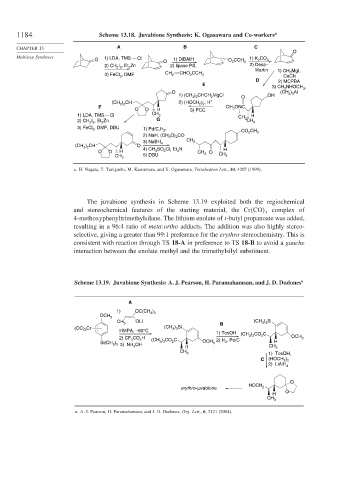Page 1208 - Advanced Organic Chemistry Part B - Reactions & Synthesis
P. 1208
1184 Scheme 13.18. Juvabione Synthesis: K. Ogasawara and Co-workers a
CHAPTER 13 A B C
O
Multistep Syntheses 1) LDA, TMS Cl CO
O O 1) DiBAIH O CCH 3 1) K 2 3
2
I , Et Zn 2) lipase PS, 2) Dess–
2) CH 2 2 2
Martin 1) CH 3 MgI,
, DMF CH CHO CCH
3) FeCl 3 2 2 3 CuCN
D 2) MCPBA
E
3) CH 3 NHOCH ,
3
) Al
O (CH 3 3
1) (CH ) CHCH MgCl O OH
2
3 2
(CH 3 ) 2 CH 2) (HOCH ) , H +
2 2
F CH ONC
O O H 3) PCC 3
1) LDA, TMS Cl CH 3 CH H
I , Et Zn G 3
2
2) CH 2 2 CH 3
, DMF, DBU
3) FeCl 3 1) Pd/C,H 2 CO CH
2) NaH, (CH O) CO 2 3
3 2
CH 3
3) NaBH 4
(CH ) CH O
3 2
2
3
3
O O H 4) CH SO Cl, Et N CH O CH H
CH 3 5) DBU 3 3
a. H. Nagata, T. Taniguchi, M. Kawamura, and K. Ogasawara, Tetrahedron Lett., 40, 4207 (1999).
The juvabione synthesis in Scheme 13.19 exploited both the regiochemical
and stereochemical features of the starting material, the Cr CO complex of
3
4-methoxyphenyltrimethylsilane. The lithium enolate of t-butyl propanoate was added,
resulting in a 96:4 ratio of meta:ortho adducts. The addition was also highly stereo-
selective, giving a greater than 99:1 preference for the erythro stereochemistry. This is
consistent with reaction through TS 18-A in preference to TS 18-B to avoid a gauche
interaction between the enolate methyl and the trimethylsilyl substituent.
Scheme 13.19. Juvabione Synthesis: A. J. Pearson, H. Paramahamsan, and J. D. Dudones a
A
1) OC(CH 3 3
)
OCH
3
CH 3 OLi B (CH ) Si
3 3
(OC) Cr HMPA, –60°C (CH ) Si
3 3
3
1) TosOH (CH ) CO C
CO H 3 3 2 OCH
2 3 3 2 2) H 2 H
2) CF 3 (CH ) CO C , Pd/C 3
Si(CH 3 ) 3 3) NH OH OCH 3
4 H CH 3
CH
3 1) TosOH,
C (HOCH )
2 2
2) LiAlH 4
O
HOCH
erythro-juvabione 2
O
H
CH
3
a. A. J. Pearson, H. Paramahamsan, and J. D. Dudones, Org. Lett., 6, 2121 (2004).

